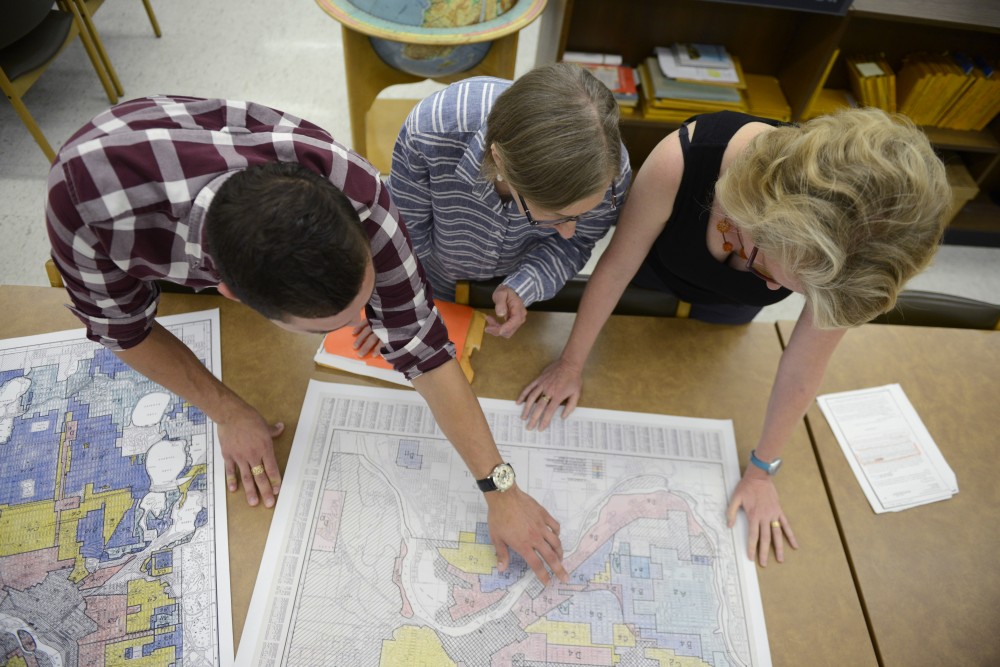This year, students who travel deep enough into the heart of Wilson Library may encounter a team of researchers working to uncover Minneapolis’ discriminatory housing history.
Scholars from the University of Minnesota and Augsburg University have analyzed over 1.4 million historic Minneapolis housing deeds and found racist language in over 20,000 documents. While these racial covenants forbidding the sale of property to people of color are no longer legally enforceable, researchers hope documenting this side of the city’s history will influence urban planning in years to come.
Inspired by a smaller mapping project in Seattle, the Mapping Prejudice Project, launched by Augsburg faculty member and project director Kirsten Delegard in 2016, seeks to find and map housing deeds — documents that govern real estate transfers — containing racist language in Hennepin County.
“I was particularly interested in what seems like a conundrum with Minneapolis. Minneapolis is hailed as this model metropolis,” Delegard said, adding that the city is known for having quality parks and schools. “Yet we have the highest racial disparities in the country.”

Many of these deeds contain language barring the land that houses sit on from being sold or rented to people of color. Violation of these deeds was a serious matter during the 20th century, as those who didn’t abide by the racial covenants could lose their land and homes, said Penny Petersen, the project’s property records specialist.
Mapping these deeds, which are dated between 1900 and 1960, requires resources from the extensive mapping collection housed at the University’s John R. Borchert Mapping Library. The collection contains historic maps essential to finding these housing lots that may no longer exist, she said.
Petersen, who analyzed a batch of 10,000 housing deeds and found 1,500 instances of these racial covenants in the project’s early stages, said the fact that Hennepin County has digitized historical housing records, unlike neighboring counties, means the researchers’ task can be more easily accomplished.
The team finds racist language by scanning these digitized records with a specialized software, said Kevin Ehrman-Solberg, Mapping Prejudice Project project manager and University graduate student.
“Reading through all of those [deeds] is just not practical. You would need an army of undergraduates, a seven-figure grant and 30 years, and then maybe you could find all of these restrictions,” he said.
Since each deed requires three readings before it can be mapped, which is a time-consuming process, researchers have turned to volunteers to manage the workload, Erhman-Solberg said.
About 275 volunteers have signed up through a crowdsourcing platform to sift through deeds, Delegard said.
The group plans to map Minneapolis by the end of 2017 and all of Hennepin County next year.

While the language in these deeds isn’t legally enforceable today, these racial covenants had a lasting impact in racial distribution across Minneapolis neighborhoods.
“Racial covenants … made it so that if you were black in the 20th century in Minneapolis, you couldn’t buy a home. You had to rent. Large swaths are covered by covenants,” Erhman-Solberg said, adding that as a result, many historically white neighborhoods are still mostly occupied by white homeowners.
Researchers also hope this data set will inform public officials’ decisions and lead to more inclusive housing and zoning policies in the future.
“If we can change this grand narrative — the narrative that Minneapolis never had racism, that there’s always been equal opportunity, that this happened by accident that we do have these racial disparities — we need to change that before we’ll have the political leverage to change policy,” Delegard said.
Correction: A previous version of this article misspelled Kirsten Delegard’s name.

















